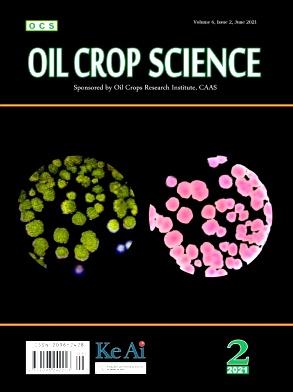Phenotyping peanut cultivars with contrasting responses to pod rot pathogens
Q3 Agricultural and Biological Sciences
引用次数: 0
Abstract
Peanut is a major cash crop in the world. In recent years, peanut pod rot has become increasingly prevalent, resulting in significant yield and quality losses. Resistance breeding is considered a cost-effective approach for managing pod rot. Previous research in the United States identified significant anatomical differences in leaves and shells among peanut cultivars with varying responses to pod rot caused by Pythium myriotylum Drechs. and Rhizoctonia solani Kuhn. However, whether similar anatomical features correlate with resistance to peanut pod rot in Laixi, Qingdao, remained unknown, where the primary causal pathogen for the disease was F. solani. In this study, nine peanut varieties with differing disease reactions to peanut pod rot were planted in the same plots. Paraffin sections of leaves and shells were prepared and stained to evaluate anatomical features, and the main agronomic traits were assessed alongside leaf spot disease ratings. All the four anatomical features, leaf palisade cell number, palisade cell width, index (palisade cell number per mm × cell width in μm), and shell lignin staining area, were measured before the onset of pod rot and were found to be negatively correlated with pod rot scores. Given the consistent and strong correlation of these anatomical features with pod rot resistance and their high heritability estimates, the pre-existing resistance could be identified even in the absence of the disease, which is particularly valuable for fields where pod rot may not occur every year. This study provided useful anatomical indicators for selecting resistance to peanut pod rot, predominantly caused by F. solani.
花生品种对豆腐病病原反应的表型分析
花生是世界上主要的经济作物。近年来,花生豆荚腐病日益普遍,造成了严重的产量和品质损失。抗性育种被认为是控制豆腐病的一种经济有效的方法。美国先前的研究发现,不同花生品种对豆腐病的反应不同,其叶片和壳的解剖差异显著。和枯丝核菌。然而,类似的解剖特征是否与青岛莱西地区对花生荚果腐病的抗性相关仍不清楚,那里的主要致病病原体是梭兰氏菌。本试验在同一地块上种植9个对花生荚果腐病反应不同的花生品种。制备叶片和壳的石蜡切片并染色以评估解剖特征,并评估主要农艺性状和叶斑病等级。在荚果腐病发生前测定叶片栅栏细胞数、栅栏细胞宽度、栅栏细胞指数(栅栏细胞数/ mm ×细胞宽度(μm))和壳木质素染色面积这4个解剖特征,发现它们与荚果腐病评分呈负相关。考虑到这些解剖特征与荚果腐病抗性的一致性和强相关性以及它们的高遗传力估计,即使在没有疾病的情况下,也可以确定预先存在的抗性,这对于每年可能不会发生荚果腐病的田地特别有价值。本研究为选择花生荚果腐病抗性提供了有益的解剖学指标。
本文章由计算机程序翻译,如有差异,请以英文原文为准。
求助全文
约1分钟内获得全文
求助全文
来源期刊

Oil Crop Science
Food Science, Plant Science, Agronomy and Crop Science
CiteScore
3.40
自引率
0.00%
发文量
20
审稿时长
74 days
 求助内容:
求助内容: 应助结果提醒方式:
应助结果提醒方式:


